SEO
Understanding Keyword Search Volume – A Guide

As you dive into the fast-paced world of SEO (search engine optimization), it’s important to understand the key concepts that will help you crush the competition and dominate the first page of Google search results.
And one critical aspect of this world is understanding keyword search volume, a metric that reveals the popularity, trends, and competition surrounding specific keywords.
By understanding the search volume of specific keywords, you can effectively optimize your content to target relevant keywords and drive organic traffic—and potentially claim a spot on that coveted first page. So I’ve prepared a quick but in-depth guide to keyword search volume to help you out:
What is Keyword Search Volume?
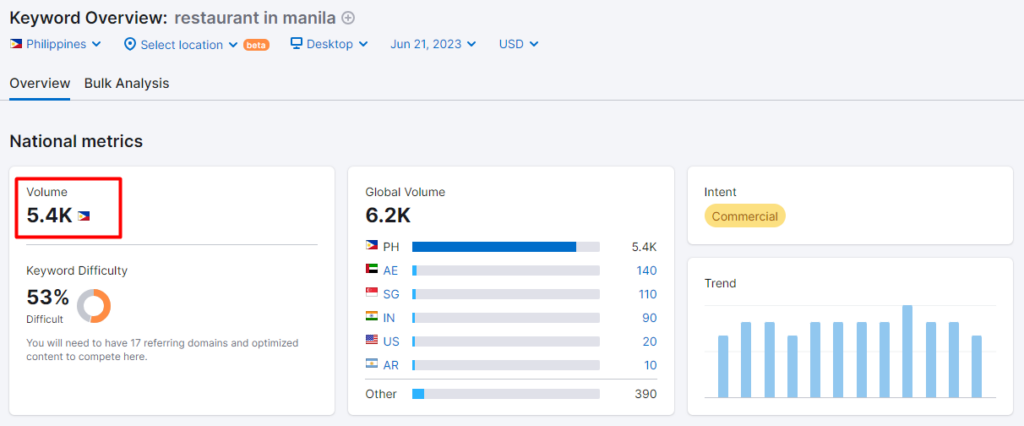
Keyword search volume is a metric that indicates the popularity and demand for a specific keyword in search engine queries. It represents the number of times a keyword is searched for within a given timeframe, usually on a monthly basis.
Why is Keyword Search Volume Important?
Keyword search volume is a valuable metric in SEO because it shows you the popularity and demand for specific keywords. By analyzing search volume data, you gain insights into the keywords that potential visitors are using to find information related to your industry or niche.
This knowledge empowers you to optimize your website’s content and meta tags to target those keywords effectively, increasing the likelihood of ranking higher on search engine result pages (SERPs). In essence, keyword search volume allows you to align your website with the interests and search behaviors of your target audience.
The Difference between Seasonal and Evergreen Keywords
It is important to consider the variations in search volume, whether they are consistent or seasonal. Within this realm, two primary categories emerge: seasonal keywords and evergreen keywords.
Let’s look at one keyword: ”number coding in Manila.”
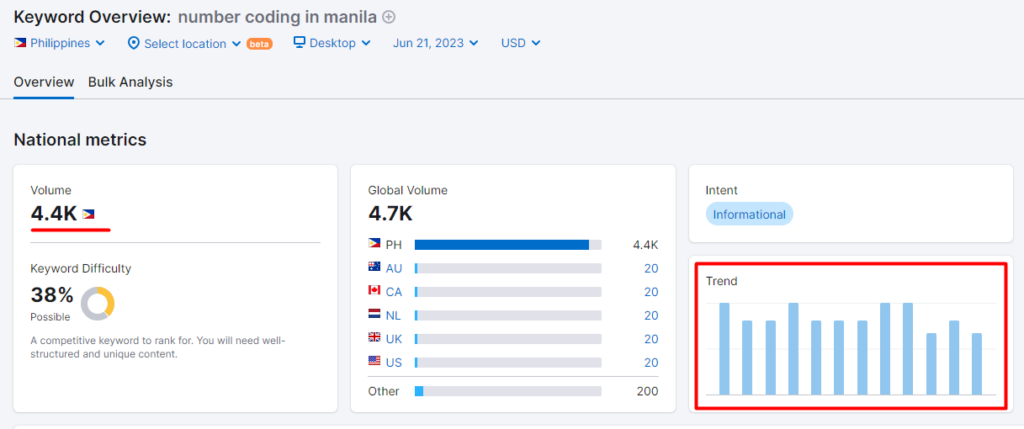
Keywords like “number coding in Manila” are a kind of keyword that you can bet a few hundred people search for every day since the need for information on this topic exists no matter what time of the year it is. This consistency means they’re evergreen, and evergreen keywords have a relatively stable search volume for pretty much the whole year.
On the other hand, seasonal keywords are directly tied to specific times of the year, which means you can see regular fluctuations in their search volumes. For example, as the holiday season approaches, people are more likely to search for terms like “holiday gift ideas.” During this period, the search volume for such keywords sharply increases, only to fall off after the holidays have passed.

To effectively evaluate keyword volume, you have to consider the potential seasonal fluctuations in search volume. By understanding which high-volume keywords are evergreen, versus what keywords might be trending because of the current season, you can better optimize your content strategy to align with your target audience’s search intent throughout the year.
Determining Good Keyword Search Volume
The definition of good keyword search volume can vary depending on various factors, including the industry, niche, and goals of a website.
Generally, a good keyword search volume is considered to indicate a healthy level of demand and relevance for a particular keyword.
While there is no universal threshold, keywords with higher search volumes often show greater potential for attracting organic traffic. However, high-volume keywords also tend to be more competitive, making achieving top rankings on search engine result pages (SERPs) more challenging.
On the other hand, keywords with very low search volumes might not generate significant traffic to your website, but they may have lower competition and therefore may be easier to rank top-of-page for. So, striking a balance between search volume and competition is crucial.
Factors to Consider in Keyword Search Volume
When evaluating the search volume of keywords for SEO, it is important to consider the following factors:
Relevance
Aligning your keywords with the interests of your target audience is arguably the most important factor. What’s the point of using a high-volume keyword, if none of the people who click on it are your target audience?
Understanding your audience’s needs, preferences, and search behaviors enables you to create content that addresses their specific pain points and provides valuable solutions. By doing so, you increase the chances of attracting qualified traffic and improve user experience (which we know to be important for a website’s visibility in search engine rankings).
Competition
The more volume a keyword has, the more competitive it likely is. It’s because they present something very enticing to any webmaster: more views, more clicks. That means there are going to be more websites targeting these keywords, and your website may not have what it takes to come out on top.
So, you have to understand how much competition you’re dealing with before settling on a keyword. While seeing a keyword volume of, say, 10,000 per month feels really tempting, it will require a ton more resources and effort to achieve high rankings on the SERPs.
By strategically targeting keywords with a balance between search volume and competition, you can increase your chances of achieving higher rankings and attracting valuable organic traffic to your website.
That said, how competitive a keyword can be will vary across different industries, niches, and geographical locations. You might come across a highly searched and potentially lucrative keyword in your research, and find that the competition for it is moderate or low enough to be a good opportunity for you.
As in many of my other guides, my advice here is the same: remember to do your research when you look into potential keywords.
Long-tail keywords
Unlike generic, broad keywords, long-tail keywords are more specific and usually consist of a phrase or a long string of words. While they may have lower search volume compared to broader keywords, they can drive highly targeted and valuable traffic to your website.
It often reflects a more refined search intent. Users who search using long-tail keywords have a clearer idea of what they are looking for. The more specific the query, the more likely that this person is really interested in what they’re searching for.
For example, someone searching for “best running shoes for flat feet” is more likely to convert into a customer than someone searching for just “running shoes.” By targeting long-tail keywords, you can align your content and offerings precisely with the needs and preferences of your audience.
While long-tail keywords may have lower search volume, they bring numerous benefits to your SEO strategy. By targeting these specific and intent-focused keywords, you can attract highly targeted traffic, experience lower competition, achieve higher conversion rates, and provide an enhanced user experience.
Adding long-tail keywords to your content strategy can help improve traffic and, ultimately, the fruits of your SEO efforts.
Search intent
Search intent refers to the underlying motivation or purpose behind a user’s search query. Understanding Search intent is crucial in SEO because it allows you to create and optimize content that aligns with what users are looking for, ensuring that your website meets their needs and provides relevant information or solutions.
Search intent can be classified into 4 different types:
- Informational intent refers to users seeking information or answers to their queries.
- Navigational intent occurs when users are searching for a specific website or brand.
- Commercial intent relates to users that are in the research phase and are comparing options before making a purchase decision.
- Transactional intent relates to users who are ready to make a purchase or complete a specific action.
By identifying the intent behind keywords, you can create content that matches the corresponding intent type and guides users through their desired journey.
How Do You Look For Keyword Volumes?
Analyzing search volume helps marketers like you understand the demand for specific keywords and make informed decisions about which ones to target. There are many ways to do this, but the most accurate way to look at search volume data is to use the right SEO tools, which are:
- Google Keyword Planner
- Google Trends
- SEMRush
- Ahrefs
- SERanking
Let’s take a look at some of the most popular tools:
Google Keyword Planner
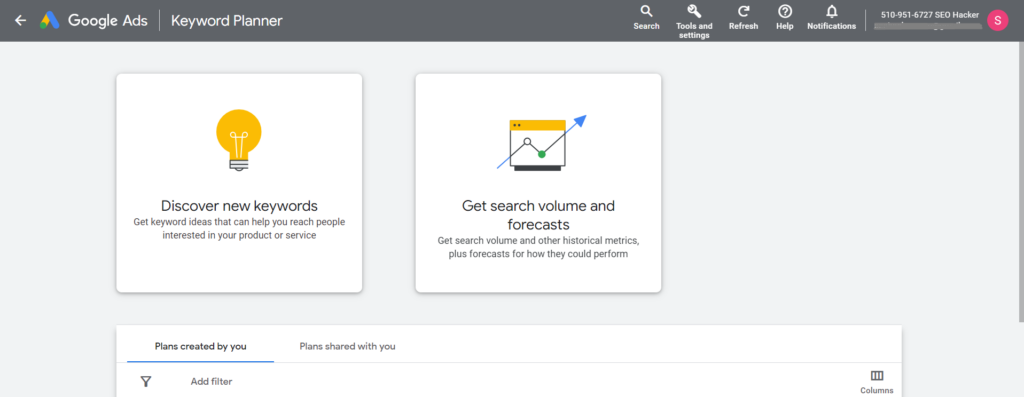
Google Keyword Planner is a free tool offered by Google Ads. While primarily designed for advertisers, it is also valuable for SEO professionals. It provides search volume data, historical statistics, and keyword ideas. By entering relevant keywords, you can access insights into average monthly search volumes, competition levels, and bid estimates. Google Keyword Planner is a great starting point for keyword research and planning SEO campaigns.
Google Trends
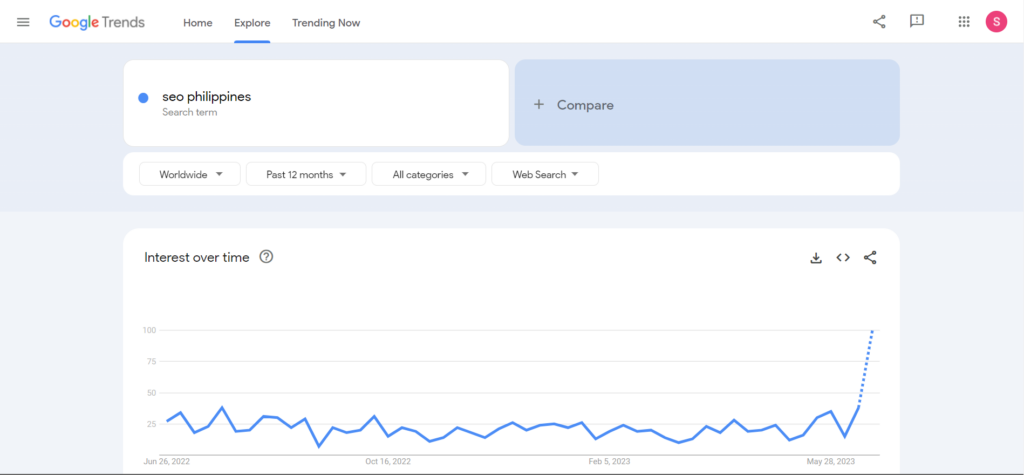
Google Trends is another free tool provided by Google. It allows users to explore the popularity and search interest of specific keywords over time. While it doesn’t provide exact search volume numbers, it shows relative interest and trending patterns. You can compare the search volume of multiple keywords, analyze regional interest, and view related queries. Google Trends is useful for identifying seasonal trends, tracking keyword popularity, and adjusting your SEO strategy accordingly.
SEMrush
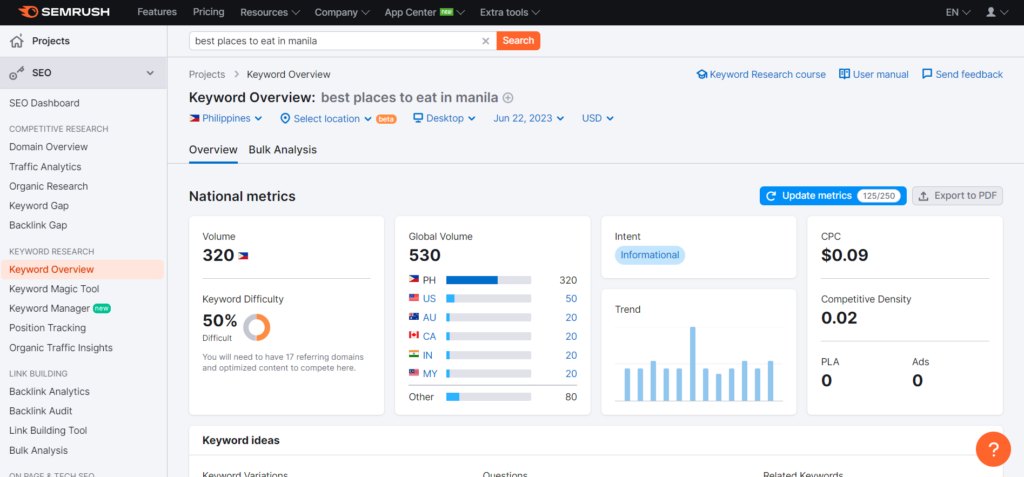
SEMrush is a comprehensive SEO tool that offers a wide range of features, including keyword research and analysis. It provides accurate search volume data along with additional insights such as keyword difficulty, competition analysis, and keyword trends. SEMrush allows you to explore search volume for specific regions and languages, discover related keywords, and analyze the performance of your competitors. With its extensive database and advanced features, SEMrush is a valuable tool for in-depth keyword research and competitive analysis.
Ahrefs
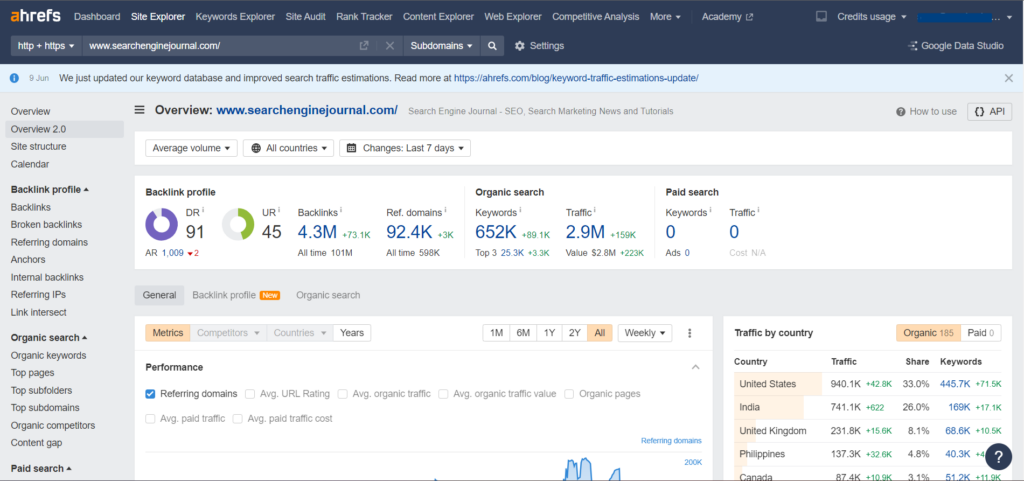
Ahrefs is a popular SEO tool known for its robust keyword research capabilities. It offers accurate search volume data, keyword difficulty scores, and related keyword suggestions. Ahrefs also provides insights into keyword trends over time and allows you to track the search volume of specific keywords. With its comprehensive features for keyword analysis and competitor research, Ahrefs helps uncover valuable keyword opportunities and optimize your SEO strategy accordingly.
SERanking
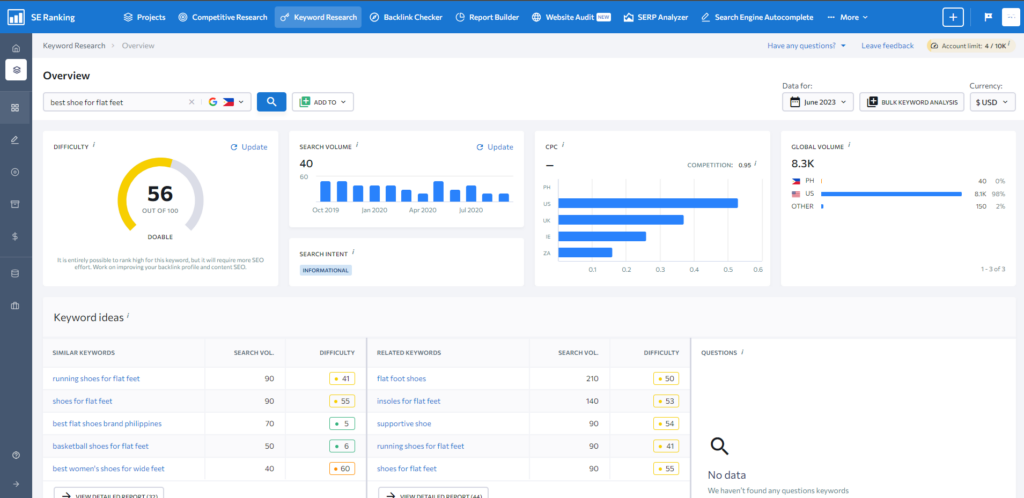
SERanking is an all-in-one SEO platform that includes features for keyword research and analysis. It offers search volume data, keyword suggestions, and competition analysis. SERanking allows you to track keyword rankings, monitor search volume fluctuations, and identify new keyword opportunities. The tool also provides comprehensive reporting options to measure the effectiveness of your SEO efforts. I wrote a more extensive review on SERanking’s content marketing platform (which includes their keyword tools) if you’re interested.
These tools are valuable resources if you want to get the most accurate and up-to-date numbers for keyword search volume. Plus, they offer some pretty valuable insights into how competitive these keywords are. I recommend exploring the features and functionalities of each tool to find the one that best fits your needs.
Benefits of Understanding Keyword Search Volume
Knowing a keyword’s search volume is crucial because it reveals the trend for that search term. From here, you can infer the keyword’s potential traffic as well as its competitiveness. Understanding that leads to some very important benefits for your SEO, such as:
Targeted Optimization
By understanding the popularity and demand for specific keywords, you can optimize your content to target relevant keywords that attract the right audience.
Increased Visibility
Optimizing your website’s content and meta tags based on keyword search volume helps improve your chances of ranking higher on search engine result pages (SERPs). This increased visibility drives more organic traffic to your website.
Competitive Advantage
Analyzing keyword search volume allows you to identify keywords that potential visitors are using to find information related to your industry or niche. By targeting these keywords effectively, you can stay ahead of the competition and align your website with the interests and search behaviors of your target audience.
Better Conversion Rates
By using long-tail keywords with lower competition and stronger search intent, you can attract highly targeted traffic to your website. These visitors are more likely to convert into customers or take desired actions, leading to improved conversion rates.
Informed Decision Making
Keyword search volume data provides valuable insights into the popularity and trends of specific keywords. This information helps you make informed decisions when selecting keywords for your content, optimizing your website, and planning your overall SEO strategy.
Key Takeaway
Now that you’ve finished this guide to keyword search volume, and seen the tools available for keyword research, it’s time to integrate this knowledge into your SEO strategy.
By analyzing keyword trends and demand using reliable tools, you can optimize your content to attract the right audience. Remember to consider important factors like evergreen versus seasonal keywords, competition levels, the value of long-tail keywords, and user intent.
Remember, SEO is a long game, as search engine algorithms continually evolve. Make sure to regularly revisit and assess your keyword search volume to ensure the list you’re targeting is still working for you and your site.
Stay proactive, adapt your strategy if needed, and maintain a strong online presence in the ever-changing SEO landscape.
SEO
Google Cautions On Blocking GoogleOther Bot

Google’s Gary Illyes answered a question about the non-search features that the GoogleOther crawler supports, then added a caution about the consequences of blocking GoogleOther.
What Is GoogleOther?
GoogleOther is a generic crawler created by Google for the various purposes that fall outside of those of bots that specialize for Search, Ads, Video, Images, News, Desktop and Mobile. It can be used by internal teams at Google for research and development in relation to various products.
The official description of GoogleOther is:
“GoogleOther is the generic crawler that may be used by various product teams for fetching publicly accessible content from sites. For example, it may be used for one-off crawls for internal research and development.”
Something that may be surprising is that there are actually three kinds of GoogleOther crawlers.
Three Kinds Of GoogleOther Crawlers
- GoogleOther
Generic crawler for public URLs - GoogleOther-Image
Optimized to crawl public image URLs - GoogleOther-Video
Optimized to crawl public video URLs
All three GoogleOther crawlers can be used for research and development purposes. That’s just one purpose that Google publicly acknowledges that all three versions of GoogleOther could be used for.
What Non-Search Features Does GoogleOther Support?
Google doesn’t say what specific non-search features GoogleOther supports, probably because it doesn’t really “support” a specific feature. It exists for research and development crawling which could be in support of a new product or an improvement in a current product, it’s a highly open and generic purpose.
This is the question asked that Gary narrated:
“What non-search features does GoogleOther crawling support?”
Gary Illyes answered:
“This is a very topical question, and I think it is a very good question. Besides what’s in the public I don’t have more to share.
GoogleOther is the generic crawler that may be used by various product teams for fetching publicly accessible content from sites. For example, it may be used for one-off crawls for internal research and development.
Historically Googlebot was used for this, but that kind of makes things murky and less transparent, so we launched GoogleOther so you have better controls over what your site is crawled for.
That said GoogleOther is not tied to a single product, so opting out of GoogleOther crawling might affect a wide range of things across the Google universe; alas, not Search, search is only Googlebot.”
It Might Affect A Wide Range Of Things
Gary is clear that blocking GoogleOther wouldn’t have an affect on Google Search because Googlebot is the crawler used for indexing content. So if blocking any of the three versions of GoogleOther is something a site owner wants to do, then it should be okay to do that without a negative effect on search rankings.
But Gary also cautioned about the outcome that blocking GoogleOther, saying that it would have an effect on other products and services across Google. He didn’t state which other products it could affect nor did he elaborate on the pros or cons of blocking GoogleOther.
Pros And Cons Of Blocking GoogleOther
Whether or not to block GoogleOther doesn’t necessarily have a straightforward answer. There are several considerations to whether doing that makes sense.
Pros
Inclusion in research for a future Google product that’s related to search (maps, shopping, images, a new feature in search) could be useful. It might be helpful to have a site included in that kind of research because it might be used for testing something good for a site and be one of the few sites chosen to test a feature that could increase earnings for a site.
Another consideration is that blocking GoogleOther to save on server resources is not necessarily a valid reason because GoogleOther doesn’t seem to crawl so often that it makes a noticeable impact.
If blocking Google from using site content for AI is a concern then blocking GoogleOther will have no impact on that at all. GoogleOther has nothing to do with crawling for Google Gemini apps or Vertex AI, including any future products that will be used for training associated language models. The bot for that specific use case is Google-Extended.
Cons
On the other hand it might not be helpful to allow GoogleOther if it’s being used to test something related to fighting spam and there’s something the site has to hide.
It’s possible that a site owner might not want to participate if GoogleOther comes crawling for market research or for training machine learning models (for internal purposes) that are unrelated to public-facing products like Gemini and Vertex.
Allowing GoogleOther to crawl a site for unknown purposes is like giving Google a blank check to use your site data in any way they see fit outside of training public-facing LLMs or purposes related to named bots like GoogleBot.
Takeaway
Should you block GoogleOther? It’s a coin toss. There are possible potential benefits but in general there isn’t enough information to make an informed decision.
Listen to the Google SEO Office Hours podcast at the 1:30 minute mark:
Featured Image by Shutterstock/Cast Of Thousands
SEO
AI Search Boosts User Satisfaction

A new study finds that despite concerns about AI in online services, users are more satisfied with search engines and social media platforms than before.
The American Customer Satisfaction Index (ACSI) conducted its annual survey of search and social media users, finding that satisfaction has either held steady or improved.
This comes at a time when major tech companies are heavily investing in AI to enhance their services.
Search Engine Satisfaction Holds Strong
Google, Bing, and other search engines have rapidly integrated AI features into their platforms over the past year. While critics have raised concerns about potential negative impacts, the ACSI study suggests users are responding positively.
Google maintains its position as the most satisfying search engine with an ACSI score of 81, up 1% from last year. Users particularly appreciate its AI-powered features.
Interestingly, Bing and Yahoo! have seen notable improvements in user satisfaction, notching 3% gains to reach scores of 77 and 76, respectively. These are their highest ACSI scores in over a decade, likely due to their AI enhancements launched in 2023.
The study hints at the potential of new AI-enabled search functionality to drive further improvements in the customer experience. Bing has seen its market share improve by small but notable margins, rising from 6.35% in the first quarter of 2023 to 7.87% in Q1 2024.
Customer Experience Improvements
The ACSI study shows improvements across nearly all benchmarks of the customer experience for search engines. Notable areas of improvement include:
- Ease of navigation
- Ease of using the site on different devices
- Loading speed performance and reliability
- Variety of services and information
- Freshness of content
These improvements suggest that AI enhancements positively impact various aspects of the search experience.
Social Media Sees Modest Gains
For the third year in a row, user satisfaction with social media platforms is on the rise, increasing 1% to an ACSI score of 74.
TikTok has emerged as the new industry leader among major sites, edging past YouTube with a score of 78. This underscores the platform’s effective use of AI-driven content recommendations.
Meta’s Facebook and Instagram have also seen significant improvements in user satisfaction, showing 3-point gains. While Facebook remains near the bottom of the industry at 69, Instagram’s score of 76 puts it within striking distance of the leaders.
Challenges Remain
Despite improvements, the study highlights ongoing privacy and advertising challenges for search engines and social media platforms. Privacy ratings for search engines remain relatively low but steady at 79, while social media platforms score even lower at 73.
Advertising experiences emerge as a key differentiator between higher- and lower-satisfaction brands, particularly in social media. New ACSI benchmarks reveal user concerns about advertising content’s trustworthiness and personal relevance.
Why This Matters For SEO Professionals
This study provides an independent perspective on how users are responding to the AI push in online services. For SEO professionals, these findings suggest that:
- AI-enhanced search features resonate with users, potentially changing search behavior and expectations.
- The improving satisfaction with alternative search engines like Bing may lead to a more diverse search landscape.
- The continued importance of factors like content freshness and site performance in user satisfaction aligns with long-standing SEO best practices.
As AI becomes more integrated into our online experiences, SEO strategies may need to adapt to changing user preferences.
Featured Image: kate3155/Shutterstock
SEO
Google To Upgrade All Retailers To New Merchant Center By September
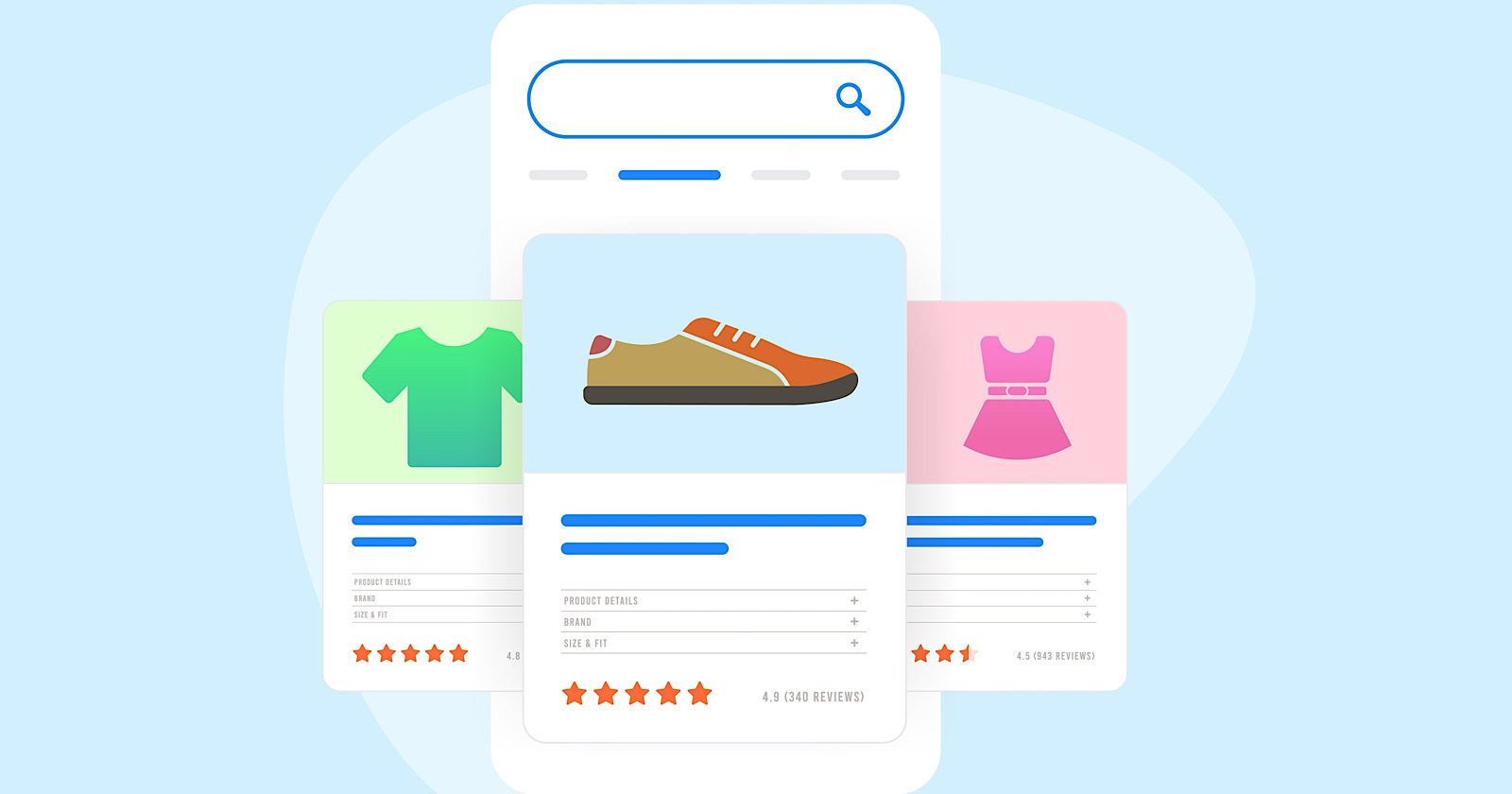
Google has announced plans to transition all retailers to its updated Merchant Center platform by September.
This move will affect e-commerce businesses globally and comes ahead of the holiday shopping season.
The Merchant Center is a tool for online retailers to manage how their products appear across Google’s shopping services.
Key Changes & Features
The new Merchant Center includes several significant updates.
Product Studio
An AI-powered tool for content creation. Google reports that 80% of current users view it as improving efficiency.
This feature allows retailers to generate tailored product assets, animate still images, and modify existing product images to match brand aesthetics.
It also simplifies tasks like background removal and image resolution enhancement.
Centralized Analytics
A new tab consolidating various business insights, including pricing data and competitive analysis tools.
Retailers can access pricing recommendations, competitive visibility reports, and retail-specific search trends, enabling them to make data-driven decisions and capitalize on popular product categories.
Redesigned Navigation
Google claims the new interface is more intuitive and cites increased setup success rates for new merchants.
The platform now offers simplified website verification processes and can pre-populate product information during setup.
Initial User Response
According to Google, early adopters have shown increased engagement with the platform.
The company reports a 25% increase in omnichannel merchants adding product offers in the new system. However, these figures have yet to be independently verified.
Jeff Harrell, Google’s Senior Director of Merchant Shopping, states in an announcement:
“We’ve seen a significant increase in retention and engagement among existing online merchants who have moved to the new Merchant Center.”
Potential Challenges and Support
While Google emphasizes the upgrade’s benefits, some retailers, particularly those comfortable with the current version, may face challenges adapting to the new system.
The upgrade’s mandatory nature could raise concerns among users who prefer the existing interface or have integrated workflows based on the current system.
To address these concerns, Google has stated that it will provide resources and support to help with the transition. This includes tutorial videos, detailed documentation, and access to customer support teams for troubleshooting.
Industry Context
This update comes as e-commerce platforms evolve, with major players like Amazon and Shopify enhancing their seller tools. Google’s move is part of broader efforts to maintain competitiveness in the e-commerce services sector.
The upgrade could impact consumers by improving product listings and providing more accurate information across Google’s shopping services.
For the e-commerce industry as a whole, it signals a continued push towards AI-driven tools and data-centric decision-making.
Transition Timeline
Google states that retailers will be automatically upgraded by September if they still need to transition.
The company advises users to familiarize themselves with the new features before the busy holiday shopping period.
Featured Image: BestForBest/Shutterstock
-

 SEARCHENGINES6 days ago
SEARCHENGINES6 days agoBillions Of Google goo.gl URLs To 404 In The Future
-
SEARCHENGINES5 days ago
Daily Search Forum Recap: July 22, 2024
-

 SEARCHENGINES7 days ago
SEARCHENGINES7 days agoGoogle Core Update Coming, Ranking Volatility, Bye Search Notes, AI Overviews, Ads & More
-

 SEO6 days ago
SEO6 days ago11 Copyscape Alternatives To Check Plagiarism
-

 SEO6 days ago
SEO6 days agoGoogle Warns Of Last Chance To Export Notes Search Data
-
SEARCHENGINES4 days ago
Daily Search Forum Recap: July 23, 2024
-

 AFFILIATE MARKETING6 days ago
AFFILIATE MARKETING6 days agoThe Top 5 AI Tools That Can Revolutionize Your Workflow and Boost Productivity
-
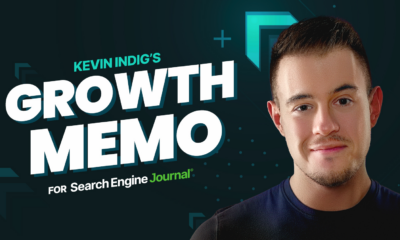
 SEO4 days ago
SEO4 days agoSystem Builders – How AI Changes The Work Of SEO











